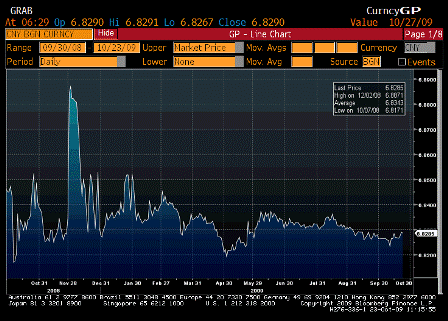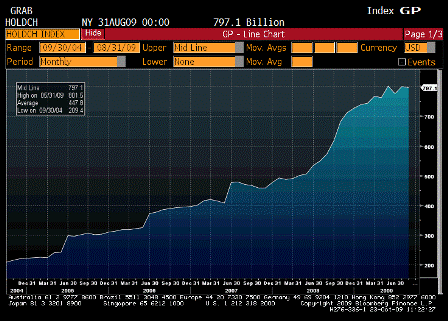I would expect the higher rates to support aggregate demand through the interest earned channels in the nations that hike rates.
Also, much of China’s lending by state owned/sponsored banks may be thinly disguised fiscal transfers that support demand. Cutting back by raising lending standards would then reduce demand. They apparently have a lot of excess capacity. The question is whether they increase demand to use it up, or slow down investment.
China Guides Bill Yields Higher, Seeking to Curb Record Lending
By Bloomberg News
Jan. 7 (Bloomberg) — China’s central bank sold three-month bills at a higher interest rate for the first time in 19 weeks after saying its focus for 2010 is controlling the record expansion in lending and curbing price increases.
Stocks fell across Asia and oil declined on concern growth will slow in China, the engine of the world economy’s recovery from its worst recession since World War II. The People’s Bank of China offered 60 billion yuan ($8.8 billion) of bills at a yield of 1.3684 percent, four basis points higher than at last week’s sale, according to a statement.
“It’s definitely a signal that the central bank is tightening liquidity,” said Jiang Chao, a fixed-income analyst in Shanghai at Guotai Junan Securities Co., the nation’s largest brokerage by revenue. “The rising yield is used to prevent excessive growth in bank lending.”
Premier Wen Jiabao said on Dec. 27 that last year’s doubling in new loans had caused property prices to rise “too quickly,” while surging commodity costs were increasing inflationary pressure. Guiding market rates higher may be a prelude to raising reserve requirements or benchmark interest rates, said Shi Lei, a Beijing-based analyst at Bank of China Ltd., the nation’s third-largest lender.
The MSCI Asia Pacific Index of regional stocks fell 0.5 percent and oil for February delivery slid 0.7 percent after 10 days of gains. Copper for three-month delivery dropped 0.7 percent. The Shanghai Composite Index fell 1.9 percent, led by Bank of China Ltd. and Industrial & Commercial Bank of China Ltd.
Tightening in Asia
“We expect some tightening of monetary policy in Asia in the first half,” said Norman Villamin, Singapore-based head of investment analysis for Asia Pacific at Citigroup Private Bank. “Markets will struggle to go higher.”
Australia’s central bank raised borrowing costs by a quarter percentage point on Dec. 1 to 3.75 percent after similar moves in November and October. The Bank of Korea, which meets tomorrow, will probably raise its benchmark rate one percentage point to 3 percent by end-2010, according to a Bloomberg survey of economists. By contrast, the Federal Reserve target rate is close to zero and policy makers last month discussed increasing asset purchases should the economy weaken.
Policy makers will seek “moderate” loan growth while managing inflation expectations, the People’s Bank said yesterday in a report on its annual work meeting. The government has told lenders to pace lending, while tightening mortgage rules for second-home purchases. Liu Mingkang, the top banking regulator, wrote in an opinion piece in Bloomberg News this week that “structural bubbles threaten to emerge” in the economy.
Bill Sales
Guotai Junan’s Jiang said the yield on benchmark one-year bills will climb in open-market operations next week. The central bank resumed sales of those bills on July 9 after an eight-month suspension to help drain cash from banks.
The central bank is set to withdraw 137 billion yuan from the financial market this week, the biggest since the week ended on Oct. 23, according to data compiled by Bloomberg News.
China’s one-year interest-rate swap, the cost of receiving a floating rate for 12 months, rose 10.5 basis points to 2.24 percent. A basis point is 0.01 percentage point.
The central bank kept the benchmark one-year lending rate at a five-year low of 5.31 percent last year after five reductions in the last four months of 2008. It may rise to 5.85 by the end of 2010, according to a Bloomberg News survey of 29 economists in November.
Lending Boom
“There’s no doubt that lending has been excessive and that explains why policy makers are starting to be more cautious about lending this year,” said Qu Hongbin, chief China economist for HSBC Holdings Plc in Hong Kong.
Qu estimates new loans will be limited to 7 trillion yuan in 2010. Banks extended an unprecedented 9.21 trillion yuan of loans in the first 11 months of 2009, compared with 4.15 trillion yuan a year earlier.
The People’s Bank said it would curb volatility in lending and monitor the property market, while reaffirming a “moderately loose” monetary policy. The statement contrasted with the start of 2009, when the central bank targeted “appropriate” increases in lending and said monetary policy would play “a more active role in promoting economic growth.”
Consumer prices climbed 0.6 percent in November from a year earlier, snapping a nine-month run of declines. The central bank is on alert for inflation after economic growth accelerated to 8.9 percent in the third quarter of 2009, the fastest in a year.
Property Prices
Housing Minister Jiang Weixin said yesterday that the nation will limit credit for some home purchases to reduce property-market speculation. Prices across 70 cities rose at the fastest pace in 16 months in November, gaining 5.7 percent from a year earlier, led by Shenzhen, Wenzhou and Jinhua.
The central bank didn’t state a 2010 target for growth in M2, the broad measure of money supply, after overshooting a 17 percent goal last year. The actual rate was more than 25 percent for most of 2009, rising to a record 29.7 percent in November.
“Growth will probably slow this year as tight credit will dampen the demand side,” said Zhang Ling, who helps oversee about $7.21 billion at ICBC Credit Suisse Asset Management Co. in Beijing. “That will dash investors’ hopes of another year of fast growth.”
[top]



